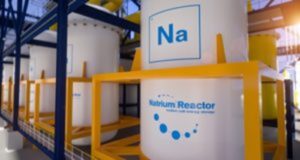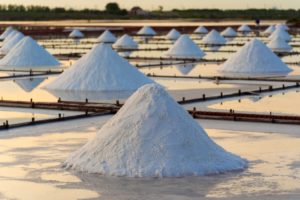High-Temperature Heat Transfer Using Molten Salts
Last updated on October 31st, 2022 at 07:05 pm
Introduction
 Composed of fluoride, chloride, and nitrate salts, Molten Salts have gained momentum due to their advantages and applications. They’re a preferred medium for heat transfer application, specifically in high temperatures and annealing (a unique heat transfer process that reduces hardness and increases the ductility of the metals) and industrial-grade process heating along with leveraging thermal storage in the solar power plants.
Composed of fluoride, chloride, and nitrate salts, Molten Salts have gained momentum due to their advantages and applications. They’re a preferred medium for heat transfer application, specifically in high temperatures and annealing (a unique heat transfer process that reduces hardness and increases the ductility of the metals) and industrial-grade process heating along with leveraging thermal storage in the solar power plants.
Engineers decide between molten salts, water-based heat transfer fluids (HTF), or oil-based heat transfer fluids based on crucial differentiators, ensuring the right heat transfer equipment. Signifiers include design parameters, the primary temperature of the process, heat transfer efficiency, and operating expenses (OpEx). Other influencing factors like flash point, vapor pressure, safety factors of flammability, toxicity, and required capital expenditure (CAPEX) for installation.
Water-based HTF vs. Oil and Molten Salt HTF
Water-based HTF is used for most low-temperature applications and less complicated parameters. Owing to its higher thermal conductivity and moderate viscosity. However, this comes at a tradeoff. The temperature application range requires high pressure to maintain the liquid phase, usually between 0°C to 100°C. When the temperature rises over 100°C and reduces vapor pressure, it results in expensive high-pressure piping and pressure vessels.
On the contrary, thermal oils offer better high-temperature performance than water-based HTF because of their ability to maintain the liquid phase for temperatures up to 300°C without the need for high-pressure piping.
Oil-based heat transfer fluids are commonly used as the heating medium for low-temperature annealing applications. However, their applicability reduces exponentially at temperatures higher than 300°C. Due to high-temperature decomposition, fuming tendencies generate toxic vapors, flammability, and a reactive state due to low stability. Making them challenging to handle at low thermal capacity.
To counter the disadvantages of using the oil-based HTF at higher temperatures, ionic salts have emerged as a viable source of thermal storage and heat transfer fluid source. There are low melting points, low volatility, a wide range of operating temperatures, and low vapor pressure that does not require high-pressure piping.
The lower tendency of fume reduces toxicity and non-flammability. However, one disadvantage molten ionic salts have is that they have a limited operating range but high thermal storage density as a thermal energy storage medium.
- The typical operating range for the individual molten salts is 260°C to 550°C.
- Below 220°C, there is a risk of freezing ionic salt in the process piping.
- At temperatures higher than 600°C, the risk of decomposition of salt increases, resulting in corrosion of process piping and pressure vessels.
Low Melting Point (LMP) Ionic Salts
 To expand the operating range of the ionic salts, low melting point salts are mixed with the remaining liquid for a wide temperature range from 250°C to 100°C.
To expand the operating range of the ionic salts, low melting point salts are mixed with the remaining liquid for a wide temperature range from 250°C to 100°C.
One typical example of such an application is a mixture of 60% NaNO3 (Sodium nitrate) and 40% KNO3 (Potassium nitrate). These mixture systems, known as a eutectic system, are homogenous mixtures. Forming a super-lattice that melts or solidifies at a much lower temperature than individual salt’s melting point.
In the case of sodium nitrate and potassium nitrate mixture, sodium nitrate has a melting point of 307°C, and the latter has a melting point of 333°C, but after they are formed into a eutectic blend. The melting point of the mixture becomes 222°C increasing the applicability of the salts for high-temperature applications.
Another standard LMP molten salt mixture is the ternary lithium nitrate, sodium nitrate, and potassium nitrate mixture, which further reduces the eutectic mixture melting point to 130°C; however, the ternary eutectic system has a maximum operating temperature of 500°C, which can limit the utilization for high-temperature application because above this temperature the lithium salt starts decomposing. This is also an expensive eutectic system due to the high price of lithium, a much sought-after element by battery manufacturers.
Molten salts in a microgrid application
Microgrids are independent, self-sufficient, intelligent energy systems that provide power to a localized setup like a hospital, residential estate, business center, or college campus.
Usually, a microgrid consists of one or more diverse sources of energy like wind or solar coupled with backup diesel or natural gas. There is usually an energy storage mechanism like Li-ion batteries or iron flow batteries which can store excess energy from the primary energy source during the peak power production period.
For microgrids powered by solar energy through plants, molten salts have emerged as preferred HTF due to their ability to handle high temperatures. A common occurrence in concentrating through solar power plants. This eliminates the need for high-pressure process piping and expensive heat exchangers, which would be required if the HTF was water or oil-based fluid.
The only risk this application entails is that temperatures can drop at night, increasing the risk of the eutectic system or binary ionic salt mixture freezing in the process piping. In such cases, backup natural gas heating systems can keep the mix above the melting point. Torresol Gemasolar project is one of the pioneer examples of the concentrating solar plant using the molten salt HTF.
Design considerations when using Molten Salts as HTF
Due to the mechanical seals and packing, many pumping systems are not compatible with the pumping of molten salts. The increase in the risk of corrosion in the system due to rising operating temperatures is found in the case of concentrating solar power through plants.
Nitrate-based salts are often stable, but they are oxidizers. Thus, in the presence of fire or open flame, they release oxygen. Causing and fueling the fire, it is advised to keep them away from ignition sources. In solar concentrating power plants, the ionic salt can be directly heated in the concentrating receiver tube, receiving energy through Parabolic mirrors.
This is a preferred arrangement, where the operating temperature increasing higher than 600°C, a combination of synthetic high-temperature fluid with the molten salt should be used where synthetic HT fluid is heated primarily in the parabolic receiver tube and then transfers heat to the molten salt storage tanks.
